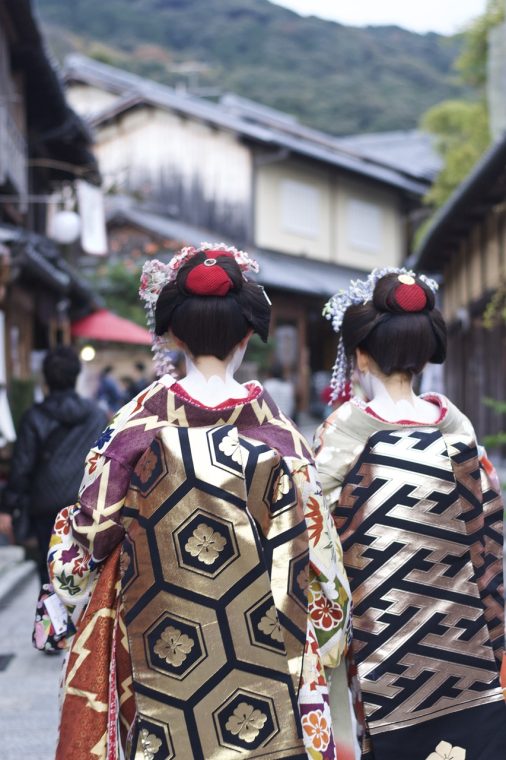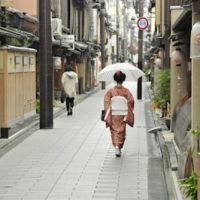The Timeless Beauty of Maiko: A Journey Through Kimono, Hair, and Makeup
S-fleage
S-fleage is a Kyoto-based company. We are proud to introduce the charms of Kyoto to the world. We hope this article will help you to experience Kyoto.
Latest posts by S-fleage (see all)
The allure of a Maiko goes far beyond her delicate dance steps and elegant presence. It’s in the vibrant colors of her kimono, the intricate design of her obi, the ever-changing hairstyles, and the striking contrast of her makeup. Each element represents a piece of a larger story — a journey from childhood to adulthood, steeped in tradition and artistry. Explore how the Maiko’s attire, makeup, and hair reveal the essence of Japanese beauty.
Contents
Kimono: The Attire of Youthful Elegance

At the heart of Maiko’s visual identity is her kimono, a garment that speaks volumes about her role, status, and age. Unlike the Geiko (the senior geisha), whose kimonos are often characterized by more subdued, mature colors and patterns, the Maiko’s kimono is a celebration of vibrant hues and intricate designs. The Maiko’s kimono is distinctly a “furisode,” or long-sleeved kimono, which is typically worn by unmarried women in Japan. The Maiko wears a specific type of furisode called a “susohiki,” which has an extended length that trails behind her. When walking outside, she lifts the front hem to prevent it from dragging on the ground. The long, flowing sleeves and bright colors of the Maiko’s kimono evoke a sense of youthful exuberance, a visual representation of her status as an apprentice.
The patterns on Maiko’s kimono are carefully selected to accentuate her youthful charm and elegance. Floral motifs, such as cherry blossoms, peonies, and chrysanthemums, are common choices, each holding its own symbolic meaning. Cherry blossoms, for example, symbolize the fleeting beauty of youth, while peonies represent bravery and honor. These motifs are often embroidered in gold and silver thread, adding a luxurious yet delicate touch to the garment.
One of the most striking features of the Maiko’s kimono is the “nui-age,” or raised stitching, which runs along the seams. Historically, this stitching was used to adjust the length of the kimono as the young Maiko grew. Today, while the practical need for this technique has diminished, it remains a charming detail that adds texture and visual interest to the outfit, reminding us of the garment’s historical roots and its role in highlighting the Maiko’s youthful innocence.
Maiko’s attire, makeup, and hairstyle | For more details about Maiko, refer to this link:
https://www.ookinizaidan.com/kagai/maiko/dressed/
The Obi: A Symbol of Innocence and Sophistication

A Maiko’s outfit would not be complete without the dramatic “darari no obi,” a long, flowing sash that hangs down the back, almost touching the ground. This obi is perhaps the most iconic aspect of Maiko’s attire, instantly recognizable for its impressive length and the way it sways with every step she takes. The darari no obi is significantly longer and heavier than a typical obi worn by a Geiko or other Japanese women, measuring over 5 meters in length. This length is meant to emphasize Maiko’s small frame, accentuating her youthful appearance.
The obi is crafted from rich, luxurious fabrics, often silk brocade, and is adorned with intricate patterns and designs woven with gold and silver threads. Traditionally, the obi’s length and weight served a practical purpose: to create a sense of innocence and girlishness by exaggerating the small size of the young Maiko’s body. As Maiko were once young girls starting their training as early as age 10, the obi helped to convey their youthful naivete and freshness.
Another distinctive feature of the Maiko’s attire is the “pocchiri,” a large ornamental clasp threaded through the obijime (the cord used to secure the obi, or sash). These pieces are often elaborately adorned with precious stones like agate, coral, and jade. Each pocchiri is a treasured heirloom, passed down through generations within the Maiko’s “okiya” (a traditional geisha house where Maiko live and are trained), from one Maiko to the next. It is said to be the most valuable item worn by a Maiko.
Hairstyles: A Visual Journey from Girlhood to Womanhood

Maiko’s hair is another distinctive element of her appearance, and unlike Geiko who wear wigs, Maiko style their natural hair. This practice is more than a mere choice of style; it is a rite of passage that reflects Maiko’s progression from girlhood to womanhood. Each hairstyle marks a specific stage in her journey as an apprentice, carrying deep symbolic meaning.
When a young girl first becomes a Maiko, she wears a hairstyle called “Wareshinobu.” This style is characterized by a divided bun at the top of the head, resembling a split chrysanthemum, with red cords and a distinctive red fabric tube inserted into the bun, creating a look reminiscent of a bouncing ball. This hairstyle is designed to highlight the innocence and naivety of a young Maiko, with the high bun adding an element of youthfulness.
As the Maiko gains experience and ages, she adopts the “Ofuku” hairstyle, which is more subdued and elegant. The Ofuku style reflects her growing maturity and the shift towards a more graceful demeanor. Maiko’s hairstyle continues to change as she progresses, each new style indicating a step closer to becoming a fully-fledged Geiko.
Hair ornaments, or “kanzashi,” are also key elements in this visual journey. These delicate accessories, often featuring flowers made from silk, are selected based on the season and the Maiko’s stage in her apprenticeship. Younger Maiko wear kanzashi with small flowers and vibrant colors, while older Maiko display larger, more subdued floral designs. The transition from youthful innocence to refined elegance is reflected in these adornments, with the final hairstyle, “Sakko,” worn just before the Maiko graduates to become a Geiko, representing the culmination of her transformation.
Makeup: The Art of Color and Contrast

Maiko’s makeup is perhaps the most immediately striking aspect of her appearance. Rooted in centuries-old traditions, her makeup palette is limited to three colors: white, red, and black. Despite this simplicity, the application is an art form in itself, with each color serving a distinct purpose to enhance the Maiko’s natural beauty and youthful charm.
The process begins with a thick, white base made of rice powder, carefully applied to the face and neck, leaving two distinct “V” shapes at the nape of the neck exposed. This detail, unique to Kyoto’s geisha, is intended to highlight the neck’s beauty, considered one of the most sensual parts of a woman in Japanese culture. The white base is essential for creating a smooth canvas, allowing the other colors to stand out.
Next comes the red makeup, delicately applied around the eyes, cheeks, and lips. The red around the eyes and cheeks is meant to give the face a soft, flushed look, reminiscent of a youthful blush. The lips are painted in a small, delicate shape, enhancing the overall impression of innocence and charm. The red also symbolizes passion and vibrancy, reflecting Maiko’s lively spirit.
Black is used to define the eyes and eyebrows, adding contrast and depth to the face. The combination of red and black against the white background creates a striking look that is both bold and delicate, embodying the Maiko’s dual nature — at once childlike and sophisticated.
Watch the next video to see the beautiful transformation of a Maiko!
Cultural Significance and Evolution

While the Maiko’s appearance is deeply rooted in tradition, it has also subtly evolved over time to reflect changes in society. The increase in the age of Maiko apprentices, for example, has led to adaptations in the way kimonos are worn and obis are tied, ensuring that the attire remains both relevant and respectful of its cultural origins.
Despite these changes, the core elements of the Maiko’s attire remain firmly in place, serving as a living testament to Japan’s cultural heritage. For many, the sight of a Maiko walking gracefully through the streets of Kyoto is a reminder of the city’s rich history and its enduring commitment to preserving beauty and tradition.
The Lasting Beauty of Maiko Tradition

The Maiko’s attire is a harmonious blend of art, culture, and tradition. From the vibrant kimono and the elegant obi to the ever-evolving hairstyles and striking makeup, each element tells a story of growth, innocence, and beauty. These elements work together to create an image that is at once timeless and ever-evolving, capturing the essence of Japanese aesthetics.
Whether you are walking the cobblestone streets of Gion or visiting a traditional teahouse, encountering a Maiko is an unforgettable experience. Her appearance is more than just a beautiful facade; it is a window into a world where tradition and elegance intertwine, inviting you to explore the depth and beauty of Kyoto’s cultural heritage.




